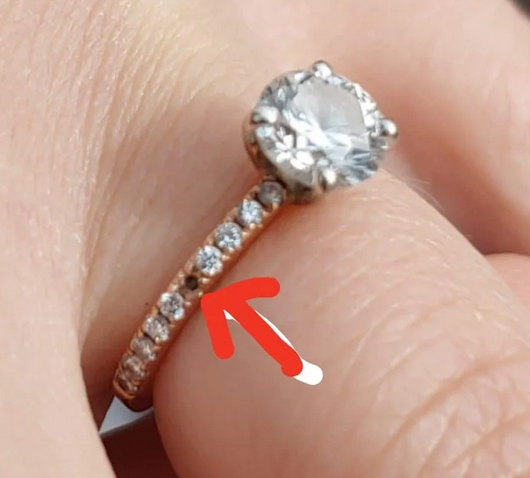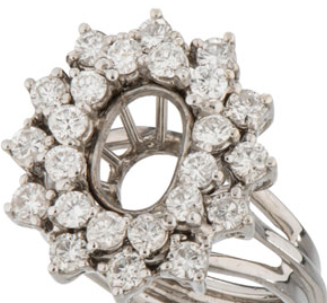Can a Diamond Fall out of a Ring?
Our product recommendations are made independently, but we may earn affiliate commissions if you use a link on this page.
A diamond ring is a beautiful thing and a huge source of pride to the wearer. Usually set in a fantastic precious metal setting the properties of a high quality well cut diamond can be eye catching and breathtaking.
This is a piece of jewelry that often means a lot to the person who owns it and if anything were to happen to it they would be very upset. Jewelry can go missing, get stolen or become damaged. In this article we are going to discuss the possibility of losing the important part of the ring, the diamond itself.
Can a Diamond Fall Out of a Ring?
The simple answer to this question is that absolutely a diamond can fall out of your ring setting and alarmingly you may not notice straight away. I can only imagine how many people throughout history have looked at their diamond ring expecting to catch a glimpse of sparkle and were met with a heartstopping absence.

Often diamonds are small enough that the only indication that they have gone is the initial lack of sparkle. Once you look closer you will see an empty and probably damaged setting where the gem used to sit. This is a harsh reality and a risk we take when we regularly wear our pride and joy diamond rings.
What Causes Diamonds to Fall Out of Jewelry?
There are a few reasons that a diamond may come loose and fall out of a ring, some we can not control but others than we can do something about to try and avoid the event occurring in the first place. I suggest you pay close attention to this section because it may give you some diamond saving tips.
The Main Causes of Lost Diamonds
- Poorly Set Diamond
If you purchase from a top quality jeweler either in person or online hopefully you get a well put together piece. That said, sometimes mistakes are made and some aspects of the diamond setting may be done poorly or could contain a fault in the setting.

Always examine your ring and gently touch the diamonds to make sure they are showing no signs of moving in their settings. If they shift in the slightest get them to a professional to either reset them or repair whatever the problem is. If you spot this early you may be covered with a warranty for the repair costs.
- Residue
During creation of the ring the jeweler will be drilling holes, burring, filing, etc. This can create microscopic residue such as metal filings, polishing rouge, etc. When a tiny diamond is set then set into the piece there is a possibility for microscopic particles to get stuck between the diamonds and the setting.
With daily wear of the ring this residue may loosen up. Also if the ring is put in an ultrasonic cleaner the residue is cleaned out. This frees up the extra space and the diamond might move, or fall out. Fortunately, when this happens in an ultrasonic cleaner, the diamond is easily found.
- Not Cleaning the Ring
Now diamond is a hard substance so getting dirty doesn’t really do much damage but when it comes to the precious metal setting allowing a buildup of dirt and bacteria can cause damage. Failing to clean the diamond ring if it is worn often can lead to damage to the setting which may loosen the diamond and allow it to fall out and be lost.
- Wear and Tear
The realities of life do not allow most of us to walk through it with one hand aloft and not in use so we can show off and protect our diamond rings. We have to lift and hold items and rings that can get bumped or knocked against things.
One of the reasons for example that pure 24k gold is never suggested for rings is that it is so soft that daily wear can dent and warp it. The more delicate a diamond ring the greater risk there is for damage when wearing it in normal day to day life.
Thin bands or delicate prongs that hold the diamond should be considered when you put on the ring. If you work a physical job that involves working heavily with your hands, wearing the ring at all times may not be a wise choice.
- Tiny Stones & Tiny Settings
As a general rule small stones in small settings such as accent diamonds are particularly at risk for being lost from a ring. These small settings are known as micro-claw and they do not amount to a lot of material holding the diamond in place.

This is a big drawback of settings such as pave, channel and cluster. These types of settings have multiple small diamonds in micro-claw settings. A hard knock against a solid surface can all too easily dislodge the small diamond causing it to fall from the ring and very likely to be lost.
If your jeweler is reputable they should warn you about how delicate small diamond settings can be. They may warn you to wear the ring with care and to take it off and store it safely if you do something particularly active.
- Side Stones
Now these are bigger than accent stones but still smaller than the main gem. As such they are more resilient than the tiny stones in the micro-claw setting but they are not as robust as a full sized diamond in a central setting.
They are also often fitted on part of the ring band that is thinner. Most rings are designed to have the ring become thinner the further you get from the main stone just for comfort of wear. With the area of the band the claws are set on being thinner it has less support and is more exposed. This means with a three-stone setup for example you are most at risk for losing one of the flanking diamonds because they are smaller in smaller claw settings.
What to Do if the Diamond Falls Out
The steps you need to take for a lost diamond will depend on when the gem was lost. If for example you literally heard the diamond drop onto something stop what you're doing, remain calm and assess what just happened. Do exactly the same if you happen to discover the gem gone but don’t know where that happened.
If It Just Fell Out
This is going to be your best case scenario if you know exactly when the diamond fell out you are right in the correct place to search for it. Take a breath, do not panic and assess your surroundings. Now if it fell in the sink and went down the plughole, keep calm the u-bend will be your savior. But make sure the water stops running.

Now diamonds can be very small and fall into little crevices so when looking for one that you know must be nearby be thorough and diligent. It could be in the fibers of a rug or wedged under a tiny gap in a baseboard.
Methodically search and if you can also enlist some help from others. This may take a while but diamonds don’t have legs if you heard it drop it can’t have gotten too far.
What if You Don’t Know Where It Was Lost?
This is where things get trickier because a diamond can get knocked out while you are walking through a store or down the street. I won't sugar coat things. The chances of locating the gem go way down when you are not sure where you lost it.
You can still try and retrace your steps and action though and you may be very lucky. Contact any stores you were in to be on the lookout for a diamond. You never know an employee may spot it and hand it in to be lost and found.
Depending on the size of the diamond you may have great difficulty finding the lost stone and if it is an accent you may just consider cutting your losses and having it replaced. A tiny accent diamond of a few mm in size is going to be virtually impossible to find in the world.
Preventing Diamond Loss
At the end of the day the way we treat our diamond ring will have a bearing on the risk we run of losing a diamond. Here are a few tips to help you protect the ring from gemstone loss:
- Have the ring serviced regularly by a professional jeweler. They can spot signs of loose gems or damaged claws which can be fixed and prevent what was likely an impending diamond escape.
- Regularly clean the ring using approved methods to stop dirt and bacteria doing damage to the setting and loosening stones.
- Do not wear delicate diamond rings while doing strenuous activity.
- Take the ring off when cleaning the house especially if you will be using harsh chemicals.
Final Thoughts
Diamonds are valuable so losing one from your treasured ring is going to feel like a nightmare. It can happen that this is a real risk if you do not take care of the piece and wear it responsibly. Regular cleaning, professional maintenance and just some basic common sense however should help to protect the ring from ever losing its prized diamond.
Reference Diamond Size Chart
If you use any of the definitions, information, or data presented on Diamond Size Chart, please copy the link or reference below to properly credit us as the reference source. Thank you!
-
<a href="https://diamondsizechart.com/blog/can-a-diamond-fall-out-of-a-ring/">Can a Diamond Fall out of a Ring?</a>
-
"Can a Diamond Fall out of a Ring?". Diamond Size Chart. Accessed on July 9, 2025. https://diamondsizechart.com/blog/can-a-diamond-fall-out-of-a-ring/.
-
"Can a Diamond Fall out of a Ring?". Diamond Size Chart, https://diamondsizechart.com/blog/can-a-diamond-fall-out-of-a-ring/. Accessed 9 July, 2025
-
Can a Diamond Fall out of a Ring?. Diamond Size Chart. Retrieved from https://diamondsizechart.com/blog/can-a-diamond-fall-out-of-a-ring/.